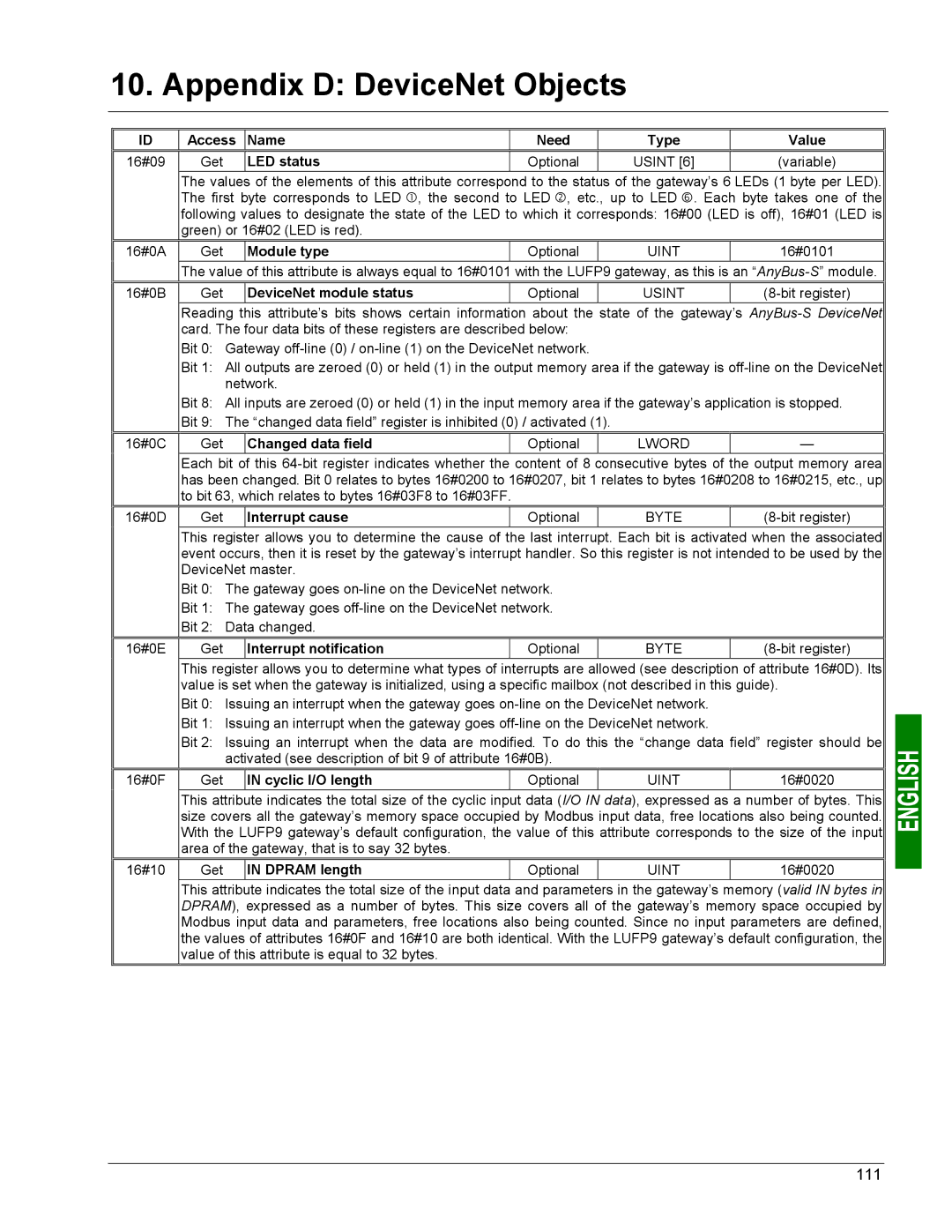
10. Appendix D: DeviceNet Objects
ID | Access | Name | Need | Type | Value |
16#09 | Get | LED status | Optional | USINT [6] | (variable) |
The values of the elements of this attribute correspond to the status of the gateway’s 6 LEDs (1 byte per LED). The first byte corresponds to LED c, the second to LED d, etc., up to LED h. Each byte takes one of the following values to designate the state of the LED to which it corresponds: 16#00 (LED is off), 16#01 (LED is green) or 16#02 (LED is red).
16#0A | Get | Module type | Optional | UINT | 16#0101 |
| The value of this attribute is always equal to 16#0101 with the LUFP9 gateway, as this is an | ||||
16#0B | Get | DeviceNet module status | Optional | USINT | |
Reading this attribute’s bits shows certain information about the state of the gateway’s
Bit 0: Gateway
Bit 1: All outputs are zeroed (0) or held (1) in the output memory area if the gateway is
Bit 8: All inputs are zeroed (0) or held (1) in the input memory area if the gateway’s application is stopped.
Bit 9: The “changed data field” register is inhibited (0) / activated (1).
16#0C
Get | Changed data field | Optional | LWORD | — |
Each bit of this
16#0D | Get | Interrupt cause | Optional | BYTE |
This register allows you to determine the cause of the last interrupt. Each bit is activated when the associated event occurs, then it is reset by the gateway’s interrupt handler. So this register is not intended to be used by the DeviceNet master.
Bit 0: The gateway goes
Bit 1: The gateway goes
Bit 2: Data changed.
16#0E | Get | Interrupt notification | Optional | BYTE |
This register allows you to determine what types of interrupts are allowed (see description of attribute 16#0D). Its value is set when the gateway is initialized, using a specific mailbox (not described in this guide).
Bit 0: Issuing an interrupt when the gateway goes
Bit 1: Issuing an interrupt when the gateway goes
Bit 2: Issuing an interrupt when the data are modified. To do this the “change data field” register should be activated (see description of bit 9 of attribute 16#0B).
16#0F
Get | IN cyclic I/O length | Optional | UINT | 16#0020 |
This attribute indicates the total size of the cyclic input data (I/O IN data), expressed as a number of bytes. This size covers all the gateway’s memory space occupied by Modbus input data, free locations also being counted. With the LUFP9 gateway’s default configuration, the value of this attribute corresponds to the size of the input area of the gateway, that is to say 32 bytes.
16#10
Get | IN DPRAM length | Optional | UINT | 16#0020 |
This attribute indicates the total size of the input data and parameters in the gateway’s memory (valid IN bytes in DPRAM), expressed as a number of bytes. This size covers all of the gateway’s memory space occupied by Modbus input data and parameters, free locations also being counted. Since no input parameters are defined, the values of attributes 16#0F and 16#10 are both identical. With the LUFP9 gateway’s default configuration, the value of this attribute is equal to 32 bytes.
111
